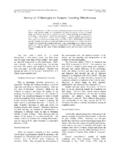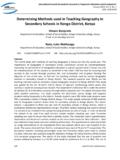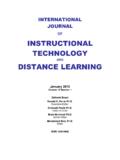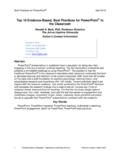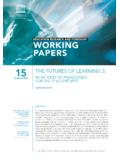Transcription of Teaching and Learning International Survey TALIS …
1 1 Organisation for Economic Co-operation and Development (OECD) Teaching and Learning International Survey TALIS 2013 conceptual Framework FINAL February 2013 International Association for the Evaluation of Educational Achievement (IEA, Amsterdam, The Netherlands) IEA Data Processing and Research Center (IEA DPC, Hamburg, Germany) Statistics Canada (Ottawa, Canada) Organisation for Economic Co-operation and Development (OECD, Paris) 2 THE TALIS 2013 conceptual FRAMEWORK Drafted by David Rutkowski, Leslie Rutkowski, Julie B langer, Steffen Knoll, Kristen Weatherby, and Ellen Prusinski With contributions from (listed alphabetically) Mara Westling Allodi, Ralph Carstens Jean Dumais Ben Jensen, Eckhard Klieme, Peter Kloosterman, Paul na Kor kov Mareike Kunter Tadakazu Miki Sang-Wan Park Svenja Vieluf Eva Wiren 3 TABLE OF CONTENTS ORGANISATION FOR ECONOMIC CO-OPERATION AND DEVELOPMENT (OECD).
2 1 Teaching AND Learning International Survey TALIS 2013 .. 1 conceptual FRAMEWORK .. 1 THE TALIS 2013 conceptual FRAMEWORK .. 2 TABLE OF CONTENTS .. 3 LISTS OF TABLES, FIGURES AND BOXES .. 4 INTRODUCTION .. 5 SECTION I GENERAL PURPOSE AND POLICY RELEVANCE OF TALIS .. 7 Indicators for system monitoring .. 9 Priority rating exercise .. 9 Themes and indicators for possible inclusion .. 12 Understanding patterns and conditions of Teaching and Learning .. 13 Building a sustainable database for policy relevant research .. 15 SECTION II KNOWLEDGE SURROUNDING THEMES AND MAIN INDICATORS .. 16 Teachers in TALIS .. 19 Background information (Teacher, Principal and School) .. 22 TALIS Themes and indicators .. 23 Theme: Teacher education, from initial education through induction to in-service professional development.
3 23 Professional development and teachers practices .. 24 Professional development and teacher retention .. 26 Professional development and teachers self-efficacy and job satisfaction .. 27 Theme: School leadership .. 27 Characteristics and distribution of principals .. 28 Distributed Leadership .. 29 School leadership and school climate .. 29 Theme: Teacher appraisal and feedback .. 30 Theme: School climate and ethos .. 32 Theme: Teachers pedagogical beliefs and practices .. 34 Teachers pedagogical practices .. 35 Conclusion .. 37 SECTION III DESIGN OF TALIS 2013 .. 38 Introduction .. 38 Brief overview of the sample 38 Brief overview of Survey instruments .. 41 Results and lessons learned from the TALIS 2008.
4 42 Areas for improvement in current and future cycles .. 43 Survey operations in brief .. 44 REFERENCES .. 47 4 LISTS OF TABLES, FIGURES AND BOXES Table 1: Possible TALIS 2013 themes with rating points ..12 Table 3: A classification of the core parts of TALIS 2013 Figure 1: International and national target and Survey populations ..39 Box 1: Definition of a teacher ..19 Box 2: The responsibilities of today s teachers ..22 Box 3: The TALIS design in brief ..38 5 INTRODUCTION1 In 2008, the initial cycle of the OECD s Teaching and Learning International Survey ( TALIS 2008) established, for the first time, an International , large-scale Survey of the Teaching workforce, the conditions of Teaching , and the Learning environments of schools in participating countries.
5 The second cycle of TALIS ( TALIS 2013 ) aims to continue the tradition of providing timely, comparable, and useful policy information regarding the conditions of Teaching and Learning environments to participating OECD countries, non-Member economies and sub-national entities ( TALIS participants). Understanding that recruiting, retaining, and developing teachers is a priority in all school systems worldwide, TALIS examines the ways in which teachers work is recognised, appraised, and rewarded. In addition, TALIS assesses the degree to which teachers professional development needs are being met. Finally, the study provides insights into the beliefs and attitudes about Teaching that teachers bring to the classroom and the pedagogical practices that they adopt.
6 Recognising the important role that school leadership plays in fostering an effective Teaching and Learning environment, TALIS describes the role of school leaders and examines the support that they give their teachers. Finally TALIS examines the extent to which factors are related to teachers feelings of job satisfaction and self-efficacy. While the design and analytic framework of TALIS should continue to evolve and adapt to changes in society and education, the Framework is also intended to establish a stable foundation for future cycles of TALIS . The Framework, then, should balance stability with innovation, as well as cycle-specific questions with more general issues. In an effort to continue to improve TALIS while simultaneously maintaining consistency, new directions for the study have been adopted for the second cycle.
7 At the same time, many of the TALIS 2008 themes, scales, and indicators have been preserved. This approach serves the dual purpose of allowing for the analysis of trends and permitting the investigation of contemporary issues in Teaching and Learning . To achieve the multiple aims of TALIS , a well-developed conceptual framework is important. The original conceptual framework for the TALIS program was developed by a joint taskforce comprised of experts from the Indicators of Education Systems (INES) Network A ( Learning outcomes) and Network C ( Learning environment and school organisation). With the second cycle of TALIS , further development and extension of the conceptual framework are warranted.
8 The updated conceptual framework draws on the previous framework and outlines the purpose and goals of the study. To put TALIS on theoretically sound footing, the conceptual framework also surveys important and current theories and research on Teaching and Learning environments. These are used to develop the dimensions, themes and indicators that were chosen by participating countries as being highly policy-relevant and which provide the organisational and conceptual underpinning of TALIS . The document is organised into five main sections: Section I elaborates on the general purpose and policy goals of TALIS and explains and justifies the type of context information needed to meet these goals.
9 Given the specific emphases and goals of the Survey , discussed subsequently, TALIS must address various factors at the system, school, and teacher levels. In the current educational policy climate, which emphasises improvement and 1 The structure of this framework document generally follows the structure used for the PISA 2012 Context Questionnaire Framework document (EDU/PISA/GB(2010)23). Although there are some similarities in content, the document was designed with the TALIS context in mind. 6 accountability, Teaching and Learning environments warrant particular attention within the TALIS conceptual framework and Survey . Section II examines the conditions of Teaching and Learning that have been selected by the participating countries in a way that is relevant to the evaluation of the main policy goals, and themes.
10 The TALIS questionnaires are designed to allow for some trend analysis between TALIS 2008, TALIS 2013 and further cycles of TALIS , while permitting for additional inquiry into areas identified as high priority by participating OECD countries, partner economies and sub-national entities. Section III describes the design of TALIS 2013 . As part of this description, the overarching design of the main study is discussed. The addition of ISCED ( International Standard Classification of Education)2 1 and 3 teachers is detailed, as is the necessity of ISCED-level specific instruments. In support of the goal of establishing trend information and effectively using information from TALIS 2008, the measures used in TALIS 2008 are revisited and measures of proven quality and relevance are identified.











